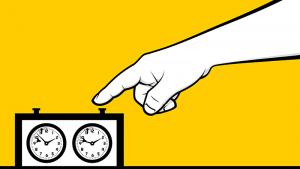
Desperado Defense
"Between two evils, I always pick the one I never tried before," quipped American actress Mae West in 1936. So it is with defending bad positions in chess. One cannot deny that in the majority of cases, the best way to test your opponent's technique is to make objectively strong moves rather than to throw pieces at them (not in the literal sense, of course) and hope for a blunder. Having outplayed you, he will expect some type of provocation or impatient lunge, and will gladly calculate two or three variations. Such a strategy might work against a very inexperienced player, but it is certainly not the way to earn a reputation as a resilient defender.
However, in his haste to finish you off, your opponent might allow you to drastically alter the nature of the position in a relatively sound manner. Hunker-down defense is a tried-and-true method, but if you see a way to throw your opponent off autopilot that cannot be directly refuted, do not be afraid to take a risk! In this article, we will determine the circumstances that permit a "desperado defense" and try to find out how grandmasters snatch half or even full points from the bloodthirsty jaws of unsuspecting opponents. Buckle up!
We will start with a relatively well-known game that features one of the most famous chess moves ever played. Take a close look:
After a horrendously misplayed opening, Spassky found himself in a nightmarish bind after just 16 moves. Black simply cannot move a muscle: his light-squared bishop is gone, his kingside is about to collapse, and there isn't a modicum of counterplay in sight. Even worse, White has all the time in the world to improve his position before launching a devastating offensive along the h-file. 16...Qg4 looks intimidating, but threatens absolutely nothing: after 17.a5!? Nd7 18.Kf1! White threatens to trap the queen with 19.Rh4 and, well, I really have no intention of continuing the analysis after 18...Nb8.

Even Houdini cannot find a way to hold out for more than 10 moves after 16...Nd7, and there is no reason to believe that Spassky, in acute time trouble and facing one of the USSR's strongest grandmasters, would have fared any better. Black's only practical chance, therefore, is to radically change the nature of the position and hope that White does not regain his bearings. Is ther any way to do so? No, I hear you say. Remember - desperate circumstances call for desperate measures. Sometimes, it is as simple as that!
I must emphasize that 16...Nc6 is not an objectively strong move; it does not lose the game immediately, but it stands no chance in the face of careful analysis. However, Spassky keenly evaluated the position (and his opponent) from a practical standpoint, and correctly concluded that he simply stood no chance in a strategically lost position against a positional virtuoso. Even though Averbakh's immediate reaction to ...Nc6 was adequate, he eventually lost the thread of the game and allowed some unbelievable endgame counterplay.
One could certainly argue that an element of luck played a role in Black's defense - after all, Averbakh overlooked a basinful of opportunities that should have yielded him the full point. This is a fair point, but I should make clear that Spassky's defense was radical even by desperado standards!
Now, I will share a game in which I drew inspiration from Spassky's audacity. To be sure, my desperado attempt occurred under far less dire circumstances, but it was brazen all the same!
The goal of both defenses we have examined so far (Averbakh-Spassky and Naroditsky-Friedel) was to add a tactical element to the game - to force the opponent to calculate and deal with pesky counterplay for more than a few moves. Of course, doing the opposite - transforming the game from tactical to quiet - can be tremendously effective as well. At the 2013 FIDE Candidates Tournament, Magnus Carlsen did so in textbook fashion:
Notice how difficult it was for Radjabov to adapt to the sudden transformation. On one move he had a mating attack, and on the next he found himself up a measly exchange with no attack in sight. No wonder he lost patience!
Defense is a thorny topic. Caught up in a web of your own tribulations, it can be challenging to place yourself in your opponent's shoes and determine the defensive method (irrespective of objective evaluation) that will pose him the maximum amount of practical difficulty. However, by cardinally changing the flow of the game and forcing your opponent to adapt to a completely different type of position, you might well induce an error even from the most battle-hardened of opponents.
RELATED STUDY MATERIAL
- Check out GM Daniel Naroditsky's previous article: How to Avoid Blunders, Part I;
- Watch GM Roman Dzindzichashvili's Greatest Chess Minds: Boris Spassky - Part 1;
- Play like Magnus in Chess Mentor;
- Sharpen your tactical edge in Tactics Trainer;
- Looking for articles with deeper analysis? Try our magazine: The Master's Bulletin.






